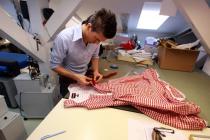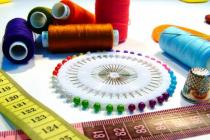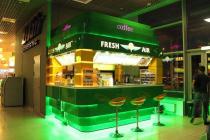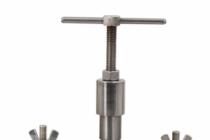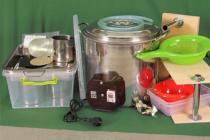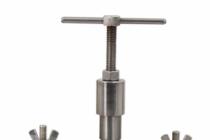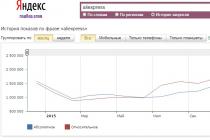People are constantly in need of new clothes, so the business of making and repairing them can be a very profitable idea. But, as in any other business, this has its own subtleties and secrets. Let's try to figure them out.
Features of the sewing business
When opening an atelier for tailoring and repairing clothes, you should not expect quick profits. At first, the income will be spent on purchasing the necessary equipment, because it is quite expensive to purchase everything at once. Expenses also depend on whether you will rent or buy a room.
One way or another, investments should be serious enough. The average tailoring business plan for a small business assumes that the establishment will pay off in a year. If you plan to deal only with repairs, it will be much cheaper to start a business. In this case, the room may be smaller, and only a couple of sewing machines will be required from the equipment.
Opening an atelier is a little more difficult, because it requires more employees and special devices. In general, a stable income can be expected from a sewing workshop of any format, even if its level is not very high.
Format selection
Before starting work, it is worth deciding how wide the profile of the institution will be. At the initial stage, you can deal exclusively with repairs, but in the long run it is not very cost-effective. Therefore, it is worth deciding right away whether your enterprise will be narrow-profile or if you plan to cover a wide range of services. In the first case, you will need to try to achieve maximum quality in a particular area, for example, in tailoring wedding dresses.
The second will require more special equipment and staff. The best solution would be a combination of several types of services, for example, clothing repair, tailoring of accessories and outerwear. An experienced seamstress in an atelier should be a versatile specialist in order to work on any order, if necessary.
paper questions
Once the format of the atelier has been chosen, it is worth doing the paperwork. You need to start by determining the legal form, and then purchase or rent a room, where you can officially register. It is important to decide in advance whether you plan to open an individual entrepreneur or LLC.
For tailoring and repairing clothes, the first option is more appropriate, as it will be easier to keep tax records and accounting calculations. When choosing a line of business, indicate a mixed direction indicating such items as the provision of personal services to the population, the production of clothing from textiles, the repair of household products and personal items. You also need to register with a pension fund, get a work permit from the fire department.
Location selection
One of the important initial stages is the selection of premises. For the first time, it is best to rent a suitable territory, and in the future it will be possible to purchase it. It is best to choose a place where there are constant flows of people. For example, you can rent a point in a shopping center.
Another good option would be a tailoring and repair shop in a residential area or a workshop near a specialized fabric store. It is also not bad when there are household services nearby, for example, for making keys. This increases the likelihood that the client will stop by on the way there and to you. To begin with, a room up to twenty square meters in size will be enough. Try to find a place with the optimal ratio of the number of visitors and the amount of rent.
Purchase of equipment
The range of special tools and sewing machines is simply huge. Buying everything at once does not make much sense, it is better to buy only the most necessary. To get started, you will need a professional model sewing machine that performs various operations, an overlock with which edges and seams are processed, a hemming machine needed to process the bottom of skirts and trousers, a good steam iron for the studio and an ironing board, a cutting table.
In addition, you need accessories such as special scissors and rippers, needles, rulers, threads, measuring tapes and thimbles. You will also need a fitting room for the studio. When choosing equipment, try to purchase new and reliable models. After buying used devices, you will have to spend money on debugging and repairing them.
Furniture and interior details
In addition to sewing equipment, before you open a clothing repair shop, you need to purchase furnishings for it.
 A cozy atmosphere will not do without good lighting and places for waiting customers, the administrator will also need a workplace.
A cozy atmosphere will not do without good lighting and places for waiting customers, the administrator will also need a workplace.
Pay attention to the quality of lamps and ceiling lights - in dim light it is unpleasant and difficult to work. Furniture for a sewing studio should be as comfortable as possible, this also applies to tables for seamstresses and sofas for visitors. The fitting room should have mannequins and hangers on which clothes will be displayed.
Among other things, you will need a certain number of fire extinguishers. About how many of them you need, you need to find out from the fire safety service. Before starting work, you will also need special forms for receipts or a cash register that will print receipts. It is illegal to receive money for your services without documentary evidence of their provision; such activities are punishable by fines.
Recruitment
 Even a well-thought-out business plan for a small business tailoring studio can be useless if the recruitment approach is wrong.
Even a well-thought-out business plan for a small business tailoring studio can be useless if the recruitment approach is wrong.
The success of an enterprise to a large extent depends on the level of the craftsmen who work in it, so experience and qualifications are of great importance. Pay attention to references from your previous job.
Tailoring has been and remains today one of the areas of business where there is not too much competition, "push", but at the same time it is possible to receive a stable high income. Especially if you are planning to open an atelier in million-plus cities, where there are many dandies and fashionistas who will not spare money to order exclusive high-quality clothes. The atelier's business plan assumes a focus mainly on a female audience: all calculations are made on the assumption that approximately 80% of clients are women.
Opening a tailoring workshop: first steps

First of all, you need to consider the accompanying infrastructure. Obviously, an atelier that makes expensive clothes from natural fabrics must have a retail outlet on its territory where customers can choose a good fabric for sewing a future frock coat or dress, purchase accessories and other trifles. In order to fully satisfy the needs of visitors, even before the opening of the atelier, contacts should be established with companies selling relevant goods, and, if possible, with online stores.
The business plan of the atelier takes into account that there will not be a constant 100% load of personnel and machines, and therefore it should be possible for the atelier staff to provide additional services for the repair of all types of clothing, sewing ready-made models for sale in retail stores.
Before starting a business, you need to decide on a place to display clothing samples. It is best if its area is at least 10 square meters. meters right at the entrance. To make the models look more spectacular, you need to purchase mannequins and make the right lighting.
When deciding on the opening hours of the atelier, it must be remembered that your clients will be busy and hard-working people, therefore, for their convenience, it is worth setting the working time to at least 19 hours on weekdays and up to 18 hours on weekends.
Requirements for the premises

It is expedient to open an enterprise on the streets with large pedestrian and car traffic, on the ground floor of residential buildings, as well as in business centers. A stand-alone building is not the best option, since your clients are likely to combine a trip to the atelier with a visit to nearby shopping or entertainment establishments. To open a business, a room of 40-45 square meters will be enough. meters, however, in the case of dynamic development, it makes sense to move to a larger office (up to 70 sq. m.), but in the same area. This will attract new customers and not lose old ones.
The studio should have three zones:
- Hall with a counter for receiving orders with fitting booths, where samples of fabrics, clothing and related materials are also presented;
- A room for cutting and tailoring things with a partition for ironing and pre-cutting processing of fabrics;
- Technical room with a bathroom, a pantry, a corner for rest and eating.
Particular attention should be paid to the place of work of seamstresses-cutters. A system of special lamps should be provided to illuminate each workplace from at least three sides. If there are no 380 V sockets in the room, it is better to take care of it right away, since many sewing equipment require just such a voltage.

In addition, the room should be well ventilated, the walls should be finished with a material that lends itself well to wet cleaning. It is highly undesirable to cover the floor with carpet or other similar materials, since it is very difficult to remove sewing waste from them.
If an open atelier receives a large number of orders, it makes sense to partially give them to craftsmen working at home, earning also on the mediation between the customer and the seamstress.
Initial investment

Note that opening an atelier is not cheap, even if you first purchase a minimum of equipment, and buy the rest in the process of business development. In addition, it is necessary to prepare the room in a special way. All costs are shown in the table below.
Many atelier owners purchase used equipment and furniture. This allows you to save up to 30% of their cost, however, when buying, the help of a person who understands the sewing business is desirable. He will be able to check the technical condition of machines and overlockers, as well as correctly connect them.
Preliminaries

Before starting work (about a month in advance), you should take care of advertising the company. The most effective will be posting leaflets within walking distance from the location of the studio, personal advertising in mailboxes, placing ads in local media and on TV, as well as advertising in partner trading establishments.
A successful advertising move is the offer of discounts on sewing and repairing clothes. Remember that it is worth starting the formation of a client base from the nearby area, gradually going out at the expense of advertising (and, of course, the quality of work) to more and more remote territories.
Recruitment

By the time the enterprise opens, you need to recruit a staff of 3 seamstresses, 2 cutters and 1 inspector. Moreover, cutters and inspectors must be interchangeable (engage in the work that needs to be done first), as well as perform the functions of clothing sellers in the atelier. Since the company will operate under a simplified taxation system, accounting services, as well as the work of a cleaning lady, should be outsourced. It is advisable to agree on cooperation with the designer, attracting him to one-time orders. The salary of seamstresses starts from 10,000 rubles, plus 20% of the cost of orders, the rest of the shop employees are on a fixed salary of 13-14 thousand rubles.
Expenses of the enterprise before reaching payback

It is assumed that the studio pays for itself in a year or a little more. Costs up to this time are shown in the table:
Note that these costs can increase or decrease by 10-15 thousand rubles, depending on the intensity of the studio.
Atelier profitability

The business plan assumes that on orders for the repair of clothes with an average order value of 320 rubles and 8 orders per day for a year, you can earn about 935 thousand rubles a year. Orders for tailoring, according to forecasts, will bring 1.825 million rubles a year (with an average order value of 2,500 rubles).
The projected profit from the operation of the outlet on the territory of the studio is 750 thousand rubles per year. Thus, the profit will amount to 3.51 million rubles per year. Excluding taxes and deductions to employees, the profit will amount to 2.1 million rubles per year. If an increase in the number of orders is predicted, it is more expedient to hire new employees, rather than increase the load on existing ones.
For your atelier to be successful, it is necessary not only to select highly qualified and experienced employees, not only to develop a client base, but also to engage exclusively in this type of business, without sharing it with others. Then the described commercial project will bring you not only the pleasure of work, but also a tangible regular income.
Dear visitors, below is an example of a business plan for an atelier for tailoring and repairing clothes with economic calculations. This template has been prepared by experts in business planning, and the calculations are prepared in Excel format, which can be adapted to your project.
If you have any questions about the preparation of a business plan or calculations, you can ask us by mail, below in the comments or in the VKontakte group.
Summary
Goal: opening a tailoring studio in the center of the city of Perm
Objectives: Opening a tailoring shop aimed at clients with higher than average incomes and providing these clients with quality services.
Initiator of the project
The initiator of the project is an entrepreneur who was previously engaged in this business on a self-employment basis. The entrepreneur decided to open an atelier due to the fact that the level of his clients is constantly growing, and it is already becoming bad to receive some clients in his apartment. In addition, the number of orders has reached such a level that he cannot cope alone.
Investment costs
The amount of investment costs will be 653 thousand rubles, which will be used mainly for repairs, purchase of equipment, tools and consumables:
- Business registration and obtaining permits - 38 thousand rubles.
- Repair of the premises - 230 thousand rubles.
- Purchase of equipment - 143 thousand rubles.
- Acquisition of a tool - 60 thousand rubles.
- Purchase of consumables - 60 thousand rubles.
- Purchase of furniture - 27 thousand rubles.
- Advertising materials - 94 thousand rubles.
As a space for the studio, it is planned to rent a room in a residential building converted into non-residential fund, which has a separate entrance overlooking the central street of the city.
Project financing
To ensure repair work, it is planned to obtain a bank loan for up to 7 years, at 15% per annum with an annuity repayment schedule. The apartment of the project initiator will be offered as collateral for the loan.
Project payback indicators
Based on the constructed calculation of the business plan of the atelier for tailoring and repairing clothes, the following project performance indicators were obtained:
- NPV - 3,658 thousand rubles;
- - 1 year;
- - 1.25 years (- 13.7%).
The calculation was based on a period of 10 years, the calculation was based on an inflation rate of 10%.
Suppliers and contractors
As a repair team, local workers will be used, who have offered the best conditions for the price and quality of work, and also have letters of recommendation, a website, and positive reviews.
As a supplier of equipment, tools and consumables, a company will be involved with which the entrepreneur has been working for a long time and from which he had previously taken equipment. There is an agreement on the supply of equipment at a 50% prepayment, which will reduce the initial investment in the business.
Services
The atelier will offer its clients the usual set of services for tailoring, repairing and restoring clothes:
- Tailoring and restoration of fur products;
- Tailoring and restoration of leather products;
- Tailoring of women's products from fabric and knitwear;
- Tailoring of men's products from fabric and knitwear;
- Tailoring of evening dresses;
- Tailoring of suits;
- Clothing restoration.
ATTENTION!!!
Practice shows that by ordering a business plan from specialists, you will save time, increase the quality of the finished document by 4-5 times and increase the chances of receiving investments by 3 times.
Investment plan
Investment size
The amount of investment in the opening of an atelier for tailoring and repairing clothes will be 1,070 thousand rubles. The cost breakdown is shown below:
| Name of works/services/equipment
|
Qty
|
Price
|
Sum
|
| Business registration |
|
|
10 000,00
|
| Obtaining permission from Rospotrebnadzor |
|
|
28 800,00
|
|
|
|
|
|
| Repair |
|
|
|
| Premises project |
|
|
30 000,00
|
| Finishing work |
|
|
100 000,00
|
| Electrical and lighting device |
|
|
100 000,00
|
|
|
|
|
|
| Equipment |
|
|
|
| Overlock |
1
|
16 500,00
|
16 500,00
|
| Straight stitch sewing machine |
3
|
25 000,00
|
75 000,00
|
| Ironing board |
1
|
20 000,00
|
20 000,00
|
| Steamer |
1
|
12 000,00
|
12 000,00
|
| cutting table |
1
|
5 000,00
|
5 000,00
|
| Iron |
1
|
5 000,00
|
5 000,00
|
| Hemming machine |
1
|
10 000,00
|
15 000,00
|
|
|
|
|
|
| Tools (scissors, rippers, needles, patterns, rulers, measuring tapes) |
|
|
60 000,00
|
| Consumables |
|
|
60 000,00
|
|
|
|
|
|
| Furniture |
|
|
|
| tables |
3
|
2 000,00
|
6 000,00
|
| Chairs |
6
|
1 000,00
|
6 000,00
|
| Clothes receiving table |
1
|
7 000,00
|
7 000,00
|
| Dressing room |
1
|
5 000,00
|
5 000,00
|
| Desk lamp |
3
|
1 000,00
|
3 000,00
|
|
|
|
|
|
| Promotional materials |
|
|
|
| Signboard |
|
|
50 000,00
|
| Website |
|
|
35 000,00
|
| Vkontakte community |
|
|
9 000,00
|
|
|
|
|
|
| TOTAL
|
|
|
653 300,00
|
Investment payment and work plan
The payment plan for investment expenses is presented in the table below (thousand rubles):
The work plan for the opening of the atel is presented in the diagram below:
room
For the atelier for tailoring and repairing clothes, a separate room was selected, located in a residential building, but having a separate exit to the central street of the city. In addition, the room has a showcase where you can display finished products and promotional materials. The layout of the room is shown in the figure below:

Below is the layout in 3D format:

Equipment
For work, equipment was selected that, according to the experience of the project initiator, has the best price / quality ratio, and is also the most maintainable and has the fewest failures.
All purchased equipment is industrial, it was immediately decided to abandon household sewing machines due to the fact that they quickly fail. Frequent failure slows down the work of the workshop - you have to give it in for repair, wait several days, and sometimes weeks until the spare part arrives. As a result, it negatively affects the company's revenue.
Working hours
For the convenience of customers, the opening hours of the atelier for tailoring clothes were made similar to the opening hours of clothing stores and shopping centers - from 10-00 to 21-00. This is due to the fact that clients with above average incomes are quite busy people and cannot afford to leave work during the working day. And so, after 18-00 there is a lot of time to get to the studio and hand over or pick up clothes.
Service delivery process
The process of rendering services of our atelier does not differ from the process of other ateliers. Quite simply, it can be described as follows:
- The client comes to the studio and makes an order (in the order he describes what he wants, provides the material);
- The designer, together with the technologist, calculates the cost of the work and tells the client.
- If the client agrees, he makes an advance payment of 50% for the work.
- Taking measurements from the client.
- The material is being purchased.
- The material is cut.
- The product is being made.
- The client comes to the first fitting.
- After fitting, the clothes are finalized.
- The client comes for the second fitting and if everything is fine, he takes the clothes and pays the remaining amount for it.
Cost of services
The main cost of the services provided is the wages of the working staff. Thus, it is planned that 60% of the cost of work will be given to piecework wages, taking into account taxes. They will be distributed differently among workers depending on the product being made, but the total amount will not change.
Marketing plan
Competition and location
The city has a large number of competitors located in different areas of Perm. However, even in spite of this, we can be sure that the project is off to a great start, since the project initiator already has regular customers who will come to the new atelier. Secondly, the company's office is located in the very center of the city, which allows it to be quite visible and attract an additional number of customers.
The studio office is located in the quiet center of the city. On the one hand, this allows you not to overpay for office rent, and on the other hand, to be in the very center and get the largest number of clients.
Range of services and prices
As part of pricing, the prices of the city for the provision of atelier services were analyzed with their division by the level of service provision. To simplify the analysis, prices are translated into an hour of work on the product. The comparison is presented in the table below (rubles/hour):
| Type of work
|
Private seamstresses
|
Low end atelier
|
middle class atelier
|
High class atelier
|
|
1 000,00
|
1 500,00
|
1 700,00
|
2 000,00
|
|
800 ,00
|
1 300,00
|
1 500,00
|
1 800,00
|
|
500,00
|
800,00
|
1 000,00
|
1 200,00
|
|
500,00
|
800,00
|
1 000,00
|
1 200,00
|
| Tailoring of evening dresses |
600,00
|
900,00
|
1 100,00
|
1 300,00
|
| Tailoring of suits |
600,00
|
900,00
|
1 100,00
|
1 300,00
|
| Clothing restoration |
500,00
|
800,00
|
1 000,00
|
1 200,00
|
Based on our office, service quality and location, we will target clients with higher than average incomes. In this regard, we plan to set prices at the level of similar high-class ateliers, namely, according to the last column of the price analysis in the city. Based on this, we can calculate the average price and margin for all types of services, taking into account the planned sales structure. The calculation is presented in the table below:
| Type of work
|
Cost price
|
markup
|
Price
|
Share in revenue
|
| Tailoring and restoration of fur products |
1 200,00
|
66,67%
|
2 000,00
|
20%
|
| Tailoring and restoration of leather goods |
1 080,00
|
66,67%
|
1 800,00
|
20%
|
| Tailoring of women's products from fabric and knitwear |
720,00
|
66,67%
|
1 200,00
|
15%
|
| Tailoring of men's products from fabric and knitwear |
720,00
|
66,67%
|
1 200,00
|
5%
|
| Tailoring of evening dresses |
780,00
|
66,67%
|
1 300,00
|
15%
|
| Tailoring of suits |
780,00
|
66,67%
|
1 300,00
|
5%
|
| Clothing restoration |
720,00
|
66,67%
|
1 200,00
|
20%
|
| TOTAL
|
900,00
|
|
1 500,00
|
100%
|
The sales structure is shown in the chart below:

Volume of sales
The average check of such similar studios is 1,000 rubles. About 30 job applications are expected per day. Thus, it turns out that the average monthly revenue of the studio is 750 thousand rubles. However, there is a slight seasonality in the tailoring business, which is shown in the chart below:

In addition, we will not be able to immediately reach such a sales volume. Since the opening, it is planned to gradually increase the volume of sales of services and achieve the optimal level of sales volume previously indicated only after 8 months. The schedule for reaching optimal sales volumes is shown in the chart below:

SWOT analysis
Strengths
- The presence of a professional team and the presence of a project initiator with extensive experience in this business
- Good office location
- New equipment
Weak sides
Difficulties
- The segment in which the atelier plans to work is the most complex. Clients are quite demanding not only on the quality of work, but also on their attitude towards themselves and the conditions of fitting.
Possibilities
- There is a possibility of expansion both in terms of the number of services already provided, and in terms of expanding the range of services.
Advertising strategy
For the fastest possible increase in sales, bringing the business to payback and loading the production staff, we will use advertising support. The campaign plan is shown below:
- Making a bright luminous sign - 60,000 rubles. (planned in the investment budget);
- Making a website and groups in social networks, where a list of services provided, prices, interesting works, contacts and other information for clients will be posted - 7 thousand rubles;
- After the launch of the atelier, contextual advertising will be actively used to attract customers - 5 thousand rubles per month;
- For our new customers, accumulative cards will be issued, which, with an increase in the number of purchases, will give more and more discounts to customers.
organizational plan
Business form
For the official work of the business, it is planned to register the project initiator as an individual entrepreneur, which will save on registration costs. It is planned that the enterprise will work on a simplified taxation system according to the “income minus expenses” system.
Personnel and staff structure
For the full-fledged work of the atelier for tailoring and repairing clothes, it is planned to hire the following employees: seamstresses, cutter, designer, cleaner, accountant (on outsourcing). The number of staff and salaries are presented in the table below:
| Job title
|
Qty
|
Salary
|
Prize
|
| Director |
1
|
20 000,00
|
|
| Administrator |
1
|
9 000,00
|
2% of revenue |
| Seamstress |
3
|
2 000,00
|
35% of the cost of work |
| Cutter |
1
|
2 000,00
|
15% of the cost of work |
| Cleaning woman |
1
|
8 000,00
|
|
| TOTAL |
7
|
41 000,00
|
|
The organizational structure of the enterprise is presented in the diagram below:

Financial plan
Prerequisites
To prepare the calculation of the business plan for a tailoring studio, we built a project payback model for 10 years in advance. The following assumptions were made to build the model;
- Annual inflation - 10%;
- Income tax - 15%;
- personal income tax - 13%;
- Social contributions - 34.2%;
- VAT - 0% (Simplified taxation system).
Project financing
To finance the project, a bank loan will be obtained for 10 years at 15% per annum with an annuity repayment schedule. This repayment schedule was chosen to minimize payments in the early days, when it would be hard for the business anyway. Differentiated payments create a very large burden on the business in the first years of its operation, when with small sales volumes you have to pay the largest amounts of interest.
Which is 490 thousand rubles. per month. According to the plan, our studio should reach this sales volume by 6 months after the start of work.
Project Sustainability Analysis
In order to determine the degree of influence of negative and positive factors on the activity of the atelier, we made an analysis of the sustainability of the project when the main indicators that affect the business change. We changed the main factors of income and expenses of the enterprise - the price of services (without changing the cost), fixed costs, the volume of investments and received the NPV indicator (an indicator reflecting the amount of project profit) with each change. The results are presented in the table below:
This analysis shows that none of the factors within our changes affects the project in such a way that it becomes unprofitable within 10 years.
Risk Analysis
Business plan calculations show quite good performance indicators. However, the development of the project may be affected by negative factors that we did not foresee in the model. Consider the most likely and most strongly influencing of them:
The fall in the income of the population is a very serious factor that can affect the amount of the company's revenue and the price of services. However, as we showed earlier in the sustainability analysis, in order for the project to become unprofitable, it is necessary that the prices of the services provided be reduced by more than 20%, and this is a significant enough decrease, the probability of which is quite small.
An increase in tax collections and non-tax deductions is a rather serious factor affecting the profitability of an enterprise, however, despite the fact that it can significantly reduce the income of a project, it certainly will not make it unprofitable.
conclusions
Considered in the business plan, the calculation of the payback of an atelier for tailoring and repairing clothes is very interesting both for the project initiator and for investors - private or credit organizations. In this connection, a loan can be allocated for this project on the conditions specified earlier in the document.

It would seem that due to the large-scale supply of clothing for any "taste and color" from China, open trade channels with Europe and America, sewing studios had to become obsolete due to the lack of demand for services. But no, the demand for the work of tailors, on the contrary, has increased dramatically, and this business has become quite popular. It is enough to look on the Internet and check the statistics on the request “ready-made business plan for a tailoring and repairing atelier”, and everything will become clear.
What is the reason for such a dynamic growth in the popularity of sewing services, we will analyze in more detail in this business plan, which, without claiming to be exceptionally complete, can serve as an excellent guide when drawing up your own action plan when organizing a sewing business, or after a little adaptation, serve as a ready-made instruction for creating a business. We warn you that all the above calculations are relevant for the second half of 2016 for Moscow and the central regions of Russia. In other areas, the indicators given in the business plan differ significantly from the real ones.
Summary
This project is a business plan for a tailoring studio with a payback period of 7-9 months.
Project goals:
- Creation of a highly profitable enterprise
- Organization of obtaining a stable profit
- Satisfying the consumer market by providing tailor-made services, clothing repair, restoration and alteration of things to another size.
Project funding source: own funds or bank loan
Form of doing business: IP
The total cost of the project: 100 - 250 thousand rubles
Payback period: 4 to 6 months
Included in the calculations interest rate: 25% per annum
The total interest payment will be: 8 334 - 31 250 rubles
The investor's income will be: 8 334 - 31 250 rubles
Payments of loan funds and interest on the loan will begin from the first month of the project.
Main stages of project implementation
The beginning of the project implementation - immediately after the acceptance of the business plan by the Customer, or after receiving credit funds.
The main stages for the implementation of this project, the conditions and terms of their implementation are presented in Table No. 1:
| Project stages | Conditions for their implementation | Deadlines for the implementation of the stages |
|---|
| project start |
| 1 month |
| obtaining borrowed funds | availability of the appropriate package of documents | 1-30 days |
| entering into the USRIP, tax and administrative registration | IP education | 1-30 days |
| purchase of premises, paperwork |
| 1 month |
| purchase and installation of equipment | getting a loan | 1 month |
| hiring |
| 1 month |
| conducting a marketing campaign |
| all the time |
General characteristics of the project (description of the company and services provided)
Premises for business organization
The search for a suitable location should meet the following factors:
- Location in a residential area of the city, or in a large shopping center. The advantage of the latter option is the high traffic of such establishments. In addition, when buying clothes, people want to put them on right away, but often small “fits” for a specific figure are needed, for example, hemming the length, for example, of jeans or trousers. But this location imposes some restrictions on the specifics of the atelier, consisting in the provision of precisely minor repairs and tailoring of things. It is unlikely that the shopping center will order tailoring to order. In addition, the cost of rent in the shopping center is much higher than in a separate building.
- The first or ground floor of a building. Any stairs are potential obstacles for clients, so the location of the studio on the floors above the first is a possible loss of visitors;
- Location of the entrance from a busy street;
- Availability of several parking spaces;
- Possibility of installation of a sign of the necessary sizes;
- Area not less than 20 sq. meters with the possibility of dividing into 3 main areas: a working room, a fitting room, and a room for receiving clients. After achieving certain results in business, the area of the premises can be increased;
- If it is possible to open an atelier next to existing clothing or fabric stores, or shoe repair shops, this will be a definite plus.
- The premises must comply with the requirements of Rospotrebnadzor and the GPN, which will determine its readiness for work and draw up an act-conclusion.

Decoration of the studio
An important condition for the comfort of clients in the studio is the visual perception of the interior. What do ordinary sewing studios look like? Carelessly laid out everywhere, only things of clients, mountains of shreds, cuts of fabrics, spare parts for sewing machines, etc. are possible. What client wants to come back here again?
It’s another matter if the room will be made a small cosmetic repair, mirrors are hung on the walls, a TV is hung, upholstered furniture is arranged, fashion magazines will be on the coffee tables. You can install a cooler, equip a small stand with recommendations on how to choose the right clothes so that they emphasize or vice versa, hide the outlines of the figure.
From such trifles, a positive impression of the client about the image of the atelier is formed, and it will be possible to say with confidence that in the event of a need, a person will no longer doubt where to go to resolve his issue.
Staff
The number of staff will directly depend on the number of clients, therefore, in the first six months of the atelier's work, the staff will consist of:
- 1 universal cutter capable of cutting both outerwear and light clothing, both for men and women;
- 2 seamstresses, concurrently taking turns performing the duties of a cleaning lady;
- Administrative director (his role can be performed personally by the owner of the atelier at the stage of business formation), taking orders, fashion designer, marketing director, etc.
The main criteria in the selection of personnel are the availability of sufficient qualifications, experience, responsibility, and decency. The remuneration of the staff of a sewing studio is often formed according to the “rate + percentage of the order amount” scheme (usually 15-30%).
In the employment contract, special attention should be paid to the point of liability of employees. Often, clients bring expensive things to the studio for repair, or material for tailoring, and in case of damage to the order, the employee must be fully responsible for his mistakes.

Business registration
As a type of doing business, it will be possible to issue an IP, or register an LLC.
OKVED codes for opening an atelier:
- 93.5 - Providing other personal services to the public (it will act as the main code);
- 18.2 - Sewing clothes from textile materials and clothing accessories;
- 18.21 - Tailoring of overalls;
- 18.22 - Tailoring of outerwear;
- 18.24 - Tailoring of other clothes and accessories for it;
- 52.74 - repair of household products, as well as items for personal use, not included in other groups.
The possible choice of the taxation system is represented by 2 most optimal regimes: STS and UTII. If desired, you can combine these two types of taxation.
For presentation to Rospotrebnadzor, agreements must be concluded with the relevant services for:
- Removal of household waste;
- Carrying out sanitary and epidemiological procedures in the studio at a certain time interval;
Each employee must have a personal medical book with an up-to-date mark on passing a hygiene test according to the sanitary minimum. Internal logs for disinfection products, household waste movement, etc. may also be required for verification.
This business does not require significant investments, and pays off relatively quickly, but these factors do not at all relieve those who want to start a business from the need to draw up a business plan for a tailoring and repairing atelier.

The economic crisis that occurred in the country in 2014 “cleansed” the market for the provision of sewing services from “random” people and unscrupulous entrepreneurs in it, and at present the level of competition for small businesses in the clothing industry is relatively low.
marketing plan
Today, the state of the consumer market for sewing services is experiencing some difficulties in attracting customers on the one hand, and the possibility of a potential rise on the other. People have become more selective in their spending, citing a decrease in income against the backdrop of a general increase in prices, but they also try to use things, in this case, wear clothes to the end, i.e. repair it instead of buying a new one.
Statistics for the last 3 incomplete years (since the introduction of sanctions against Russia) show that over the past period of time the ratio of closed sewing studios to those opened is approximately 5:2. There have also been fundamental changes in the specifics of services. If until 2014 the order for tailoring was very popular, now the demand for clothing repair has increased. The exceptions are well-known model houses and eminent couturiers.

In itself, opening a sewing studio from scratch requires minimal costs. An economy-class establishment serving low- and middle-income customers can start operating at 7-10 sq. meters of the room, having a couple of old sewing machines in its “armament”. As the “promotion” of the atelier “acquires” a client base, popularity, acquires new equipment, and increases the staff.
The main advantage in the competitive struggle of sewing ateliers has now become the professionalism of its staff. If a few years earlier some workshops could refuse complex orders, or perform them not as well as the customer would like, now, in tough economic conditions, the number of “hacks” has been weeded out, and the remaining fashion designers compete with each other in tailoring art.
Similar business idea:
The complexity of orders entails the need for qualified personnel. Now, few craftsmen will be able to turn the product, replace the lining in the coat, or eliminate the wear of the fur. In addition, this work requires special equipment.
The owners of the atelier, or those responsible for marketing and working with clients, should look for customers (namely, look for, and not wait for the person to come to the establishment!) Not only among people “from the street” and acquaintances. Large orders to positively proven ateliers come from various dance groups, theaters, and collectors. Uniforms and military clothing, etc. are in great demand.
To form a consumer opinion about the studio and attract the client mass, it is necessary to carry out the following activities:
- Place advertisements in public and specialized local print media and on TV;
- Place ads in secondary schools that train seamstresses, dressmakers, and cutters;
- Create your own website describing the services and prices of the atelier;
- Distribution of leaflets, flyers;
- Periodically hold various promotions, introduce a discount system.
Do not forget the owner of the atelier himself and bring to the consciousness of each employee that the best advertising is a high-quality order, the wages of all employees depend on this.
The average prices for atelier services in the Central Federal District are shown in Table No. 2:
| Tailoring of women's clothing | Cost, rub. | Repair of men's clothing (jeans | Cost, rub. |
|---|
| jacket tailoring | 8000-10000
| shorten (sew)
line | 300-400
|
| skirt tailoring | 5000-6500
| Shorten with "cooked
edge" | 400-500
|
| tailoring of trousers | 4500-6500
| Sew on the middle
seam | 500-600
|
| dress tailoring | 5000-8000
| Zipper Replacement | 300-450
|
| sewing a winter coat | 12500-18000
| Darn | from 350 |
| sewing overalls | 8000-10000
| Sew on the sides
(stepping) | 250-300 per seam |
Production plan
Basic equipment for a sewing studio:
- Sewing machines for various purposes - straight stitch, hemming, knitting, furrier (for working with skins and furs);
- Overlock;
- steam generator;
- irons;
- Mannequins;
- Tailoring tools (needles, scissors, measuring tape, etc.);
- Ironing board;
- Patterns;
- cutting table;
- Hangers;
- Other accessories, oils for cars and other devices;
- Computer for storing and processing information on orders;
- MFP for scanning, copying, and printing the necessary images and texts.
In order to save equipment when opening a studio, you can buy used equipment, subsequently replacing it with a new one, and selling the old one.

Financial section
The main taxes payable are shown in Table No. 3:
| Type of tax | tax base | Period | Interest rate |
|---|
| income tax | Incoming profit | Month | 20%
|
| Property tax | Estimated value of the property | According to the payment schedule | 2,2%
|
| VAT | Added value | Month | 18%
|
| Income tax | payroll fund | Month | 13%
|
| Social payments | payroll fund | Month | 34%
|
An approximate plan for the provision of sewing services to the population during the reporting period (until the project pays off) is presented in Table No. 4:
| Period | Type of service | The volume of these services per month | Service cost, rub. | Revenue, rub. |
|---|
| 1-3 month | tailoring | 50
| 500-18000
| 25000-900000
|
| 1-3 month | Clothing repair | 100
| 200-3000
| 20000-300000
|
| 4-6 month | tailoring | 70
| 550-20000
| 38500-1400000
|
| 4-6 month | Clothing repair | 150
| 250-3500
| 37500-525000
|
Conclusion
The presented business plan for a sewing studio for a small business and the study conducted in it showed that the organization of an atelier is currently a very promising and profitable project. One of the most important conditions for its successful work is the professionalism of the staff. Thus, the implementation of the project can be considered expedient, and the business plan of the sewing studio can be recommended for execution.
How to open a sewing studio - expert advice
2023
newmagazineroom.ru - Accounting statements. UNVD. Salary and personnel. Currency operations. Payment of taxes. VAT. Insurance premiums




 A cozy atmosphere will not do without good lighting and places for waiting customers, the administrator will also need a workplace.
A cozy atmosphere will not do without good lighting and places for waiting customers, the administrator will also need a workplace. Even a well-thought-out business plan for a small business tailoring studio can be useless if the recruitment approach is wrong.
Even a well-thought-out business plan for a small business tailoring studio can be useless if the recruitment approach is wrong.



















